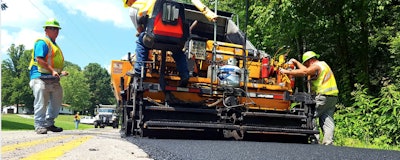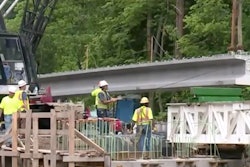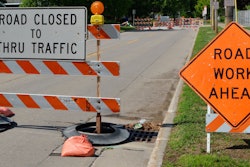 Ohio has been able to boost its highway investments through the use of Ohio Turnpike bond proceeds, but state highway funding is slated to decrease significantly in 2019. A new report lists ODOT projects that will be funded, and others that face funding shortfalls – as well as the costs to drivers for operating on rough roads. Photo: Ohio Department of Transportation.
Ohio has been able to boost its highway investments through the use of Ohio Turnpike bond proceeds, but state highway funding is slated to decrease significantly in 2019. A new report lists ODOT projects that will be funded, and others that face funding shortfalls – as well as the costs to drivers for operating on rough roads. Photo: Ohio Department of Transportation.The annual cost of ailing infrastructure on individual motorists is spelled out in dollars and cents in a new report on the status of Ohio’s roads and bridges.
Problems associated with rough and congested roads are costing Ohio as much as $2,180 per driver each a year in some urban areas, according to the report released June 21 by TRIP, a Washington, D.C.-based national transportation research organization.
“Roads and bridges that are deteriorated, congested or lack some desirable safety features cost Ohio motorists a total of $12 billion statewide annually – as much a $2,180 per driver in some urban areas – due to higher vehicle operating costs, traffic crashes and congestion-related delays,” a press release says.
The report, “Modernizing Ohio’s Transportation System: Progress and Challenges in Providing Safe, Efficient and Well-Maintained Roads, Highways and Bridges,” finds that throughout Ohio, about one in three major locally- and state-maintained urban roads are in poor or mediocre condition.
Traffic congestion throughout Ohio is worsening, costing drivers in the state’s largest urban areas as much as $1,057 annually in lost time and wasted fuel.
Drivers in the most congested areas lose 44 hours each year – more than five working days – stuck in traffic congestion, the research found.
Seven percent of Ohio’s bridges are structurally deficient, with significant deterioration to the bridge deck, supports or other major components, the report says.
There’s no easy solution on the horizon. The state department of transportation projects faces a funding shortfall of $14 billion through 2040, the report says.
Investment in transportation improvements at the local, state and federal levels could relieve traffic congestion, improve road, bridge and transit conditions, boost safety and support long-term economic growth in Ohio, the report says.
TRIP’s report examines the impact of additional funds provided largely by the use of Ohio Turnpike bond proceeds. It also documents the state’s significant short-term and long-term transportation funding shortfalls.
The report lists needed transportation projects in the state’s largest urban areas that have adequate funding to proceed by 2023, and it also lists needed projects in each area that lack funding to proceed.
In addition to statewide information, the report contains regional data for Cincinnati, Cleveland-Akron, Columbus, Dayton and Toledo. Details are posted on TRIP’s website.
Detailing the hit to drivers’ pocketbooks, the calculations include the cost to motorists of insufficient roads in each of those urban areas.
These costs come in the form of extra vehicle operating costs (VOC) as a result of driving on roads in need of repair, lost time and fuel due to congestion-related delays, and the costs of traffic crashes in which roadway features likely were a contributing factor, the report says.
Progress has come, to be sure, as the Ohio Department of Transportation (ODOT) was able to invest $2 billion in the state’s transportation system in 2017 and $2.35 billion in 2018.
But investment is set to drop to $1.85 billion in 2019 and to $1.7 billion in 2021, TRIP says.
Report: 35 percent of roads “poor” or “mediocre,” so drivers pay higher operating costs
The TRIP report finds that 23 percent of Ohio’s major urban roads are in poor condition and 12 percent are in mediocre condition, costing the state’s drivers a total of $3.5 billion each year in extra vehicle operating costs, including accelerated vehicle depreciation, additional repair costs, and increased fuel consumption and tire wear.
“The serious and in some cases horrendous condition of transportation infrastructure warrants immediate discussion and attention at the local, state and federal levels of government,” says Hamilton County Engineer Ted Hubbard.
“Our economy and future are directly tied to a transportation system of safe, dependable and efficient roads and bridges. The TRIP report clearly documents the existing condition of transportation infrastructure in Ohio and concisely illustrates the direct impact an efficient transportation system has on a healthy economy.”
“The TRIP report succinctly outlines current transportation infrastructure conditions and how transportation impacts economic development in Ohio,” says Brian O. Martin, AICP, executive director of the Miami Valley Regional Planning Commission.
“Businesses look to relocate and grow in a region with a robust transportation system and our region continues to lag. Insufficient local and state resources require an immediate increase in federal funding to shore up the region’s deficient infrastructure so that we can compete. Our elected representatives in Washington, D.C. must address this issue sooner than later.”
The efficiency and condition of Ohio’s transportation system, particularly its highways, is critical to the health of the state’s economy, the report notes.
“Annually, $1.1 trillion in goods are shipped to and from sites in Ohio, relying heavily on the state’s network of roads and bridges. Increasingly, companies are looking at the quality of a region’s transportation system when deciding where to re-locate or expand.” Regions with congested or poorly maintained roads may see businesses relocate, the report advises.
“These conditions are only going to get worse, increasing the additional costs to motorists, if greater investment is not made available at the state and local levels of government,” says Will Wilkins, TRIP’s executive director. “Without adequate funding, Ohio’s transportation system will become increasingly deteriorated and congested, hampering economic growth, safety and quality of life.”
Additional investment has allowed the state to move forward with needed transportation projects, but many projects remain stalled due to a lack of available funding.
Serious and fatal traffic crashes tied to roadway design cost billions
TRIP estimates that the economic costs of serious and fatal traffic crashes in Ohio, in which roadway design was likely a contributing factor, is $3.9 billion each year.
These costs come in the form of lost household and workplace productivity, insurance and other financial costs.
Traffic crashes in Ohio claimed the lives of 5,360 people between 2012 and 2016. That’s an average of 1,072 fatalities per year. The fatality rate on Ohio’s non-interstate rural roads in 2016 was approximately two-and-a-half times higher than on all other roads in the state.
Inflation eroding buying power of user-fee money
The largest source of federal and state road, bridge and highway funding in Ohio is the federal and state motor fuel user fees.
“The buying power of both the federal and state motor fuel user fee have been significantly eroded due to inflation,” the report says.
“The buying power of the federal 18.4 cents-per-gallon gasoline and 24.4 cents-per-gallon diesel motor fuel user fee, which was last increased in 1993, has had its buying power reduced to 10.7 and 14.2 cents-per-gallon, respectively, due to the impact of inflation.
“Similarly, the buying power of the Ohio 28 cents-per-gallon user fee, which was last increased in 2005, has been reduced to 18 cents-per-gallon as a result of inflation.”












